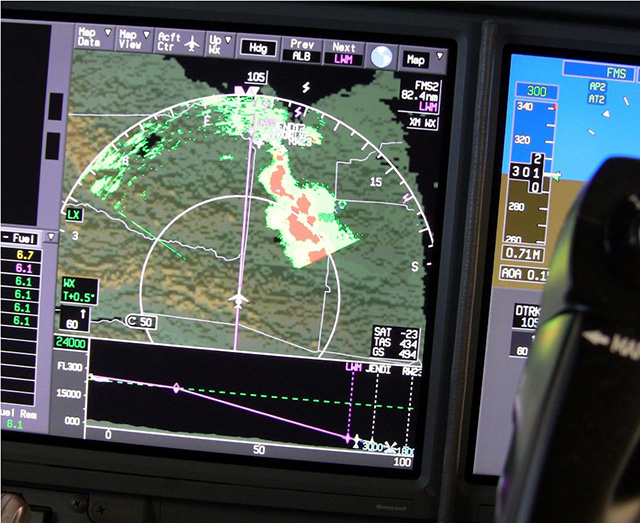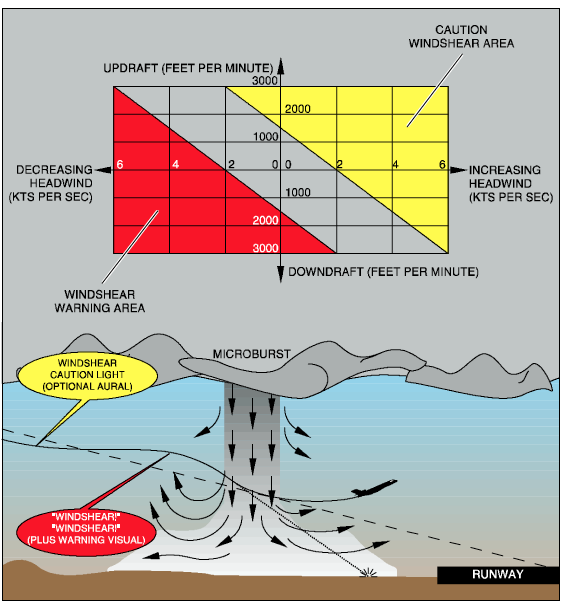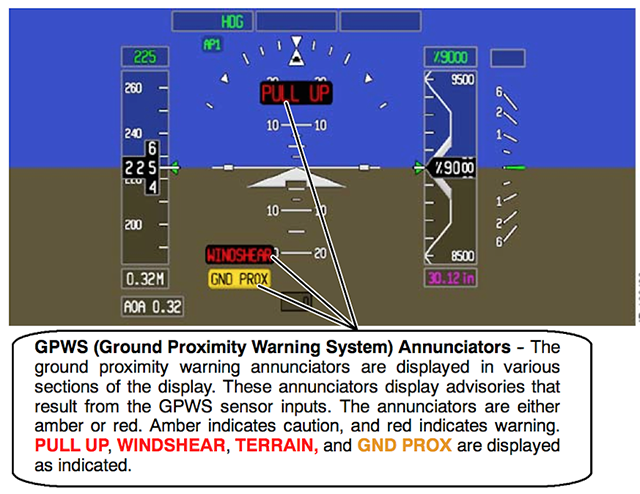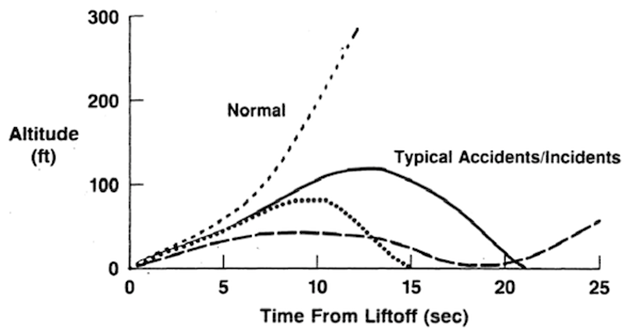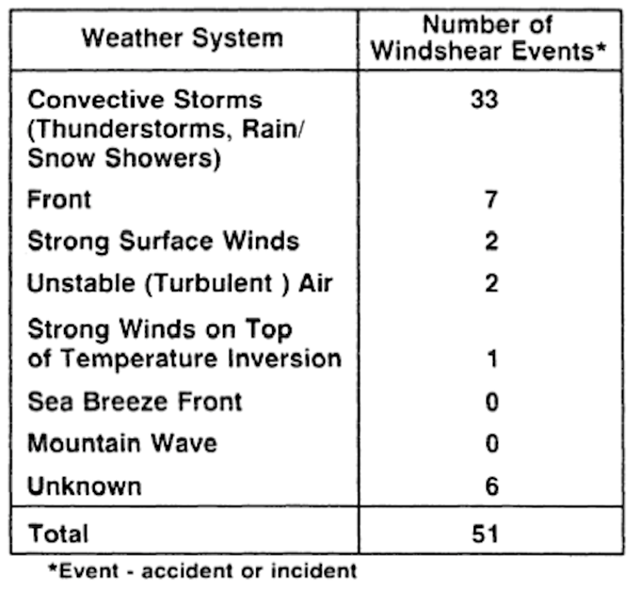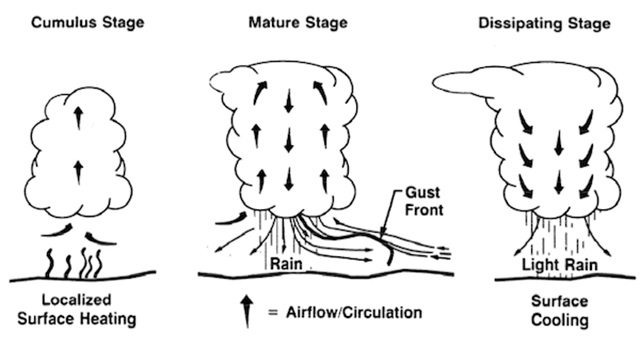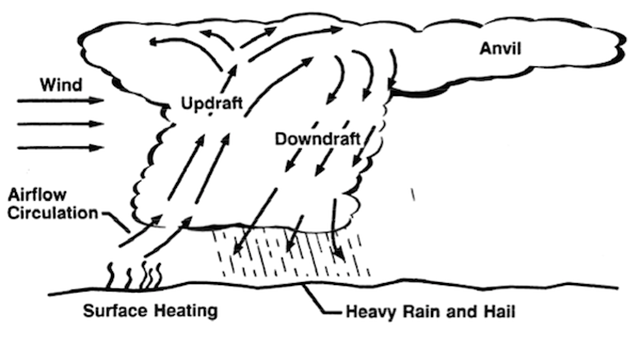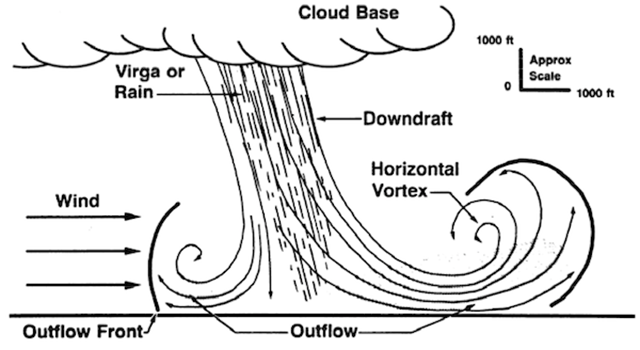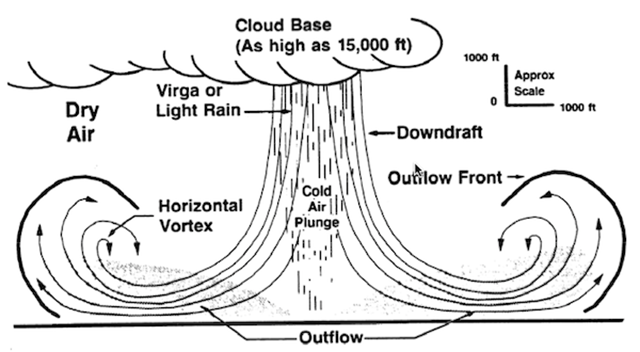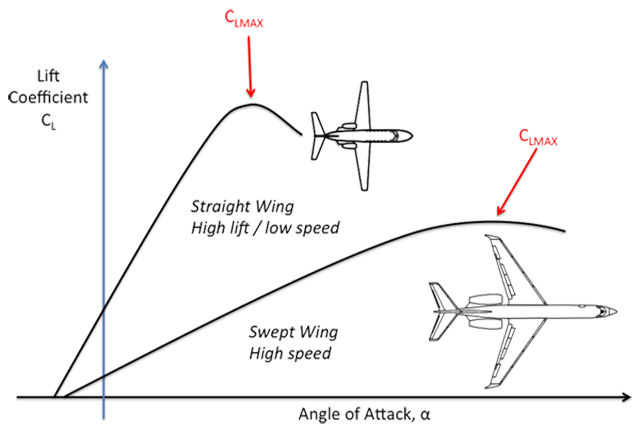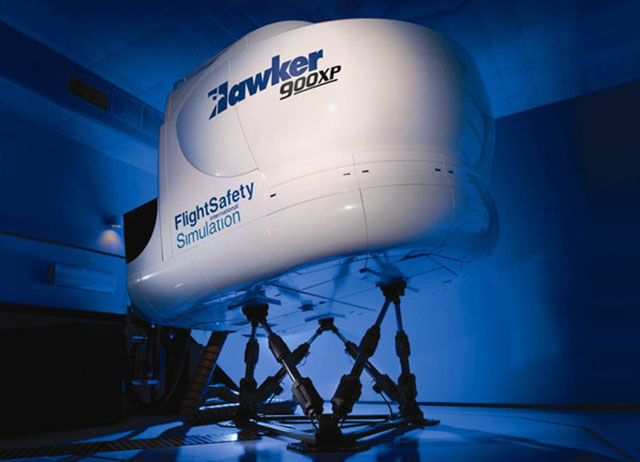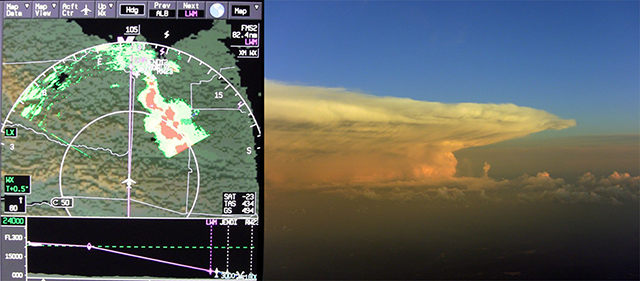We pilots have always been a bit self-deluding when it comes to windshear. At first, we didn't even recognize it as a problem and chalked up the occasional loss of an airplane to pilots who didn't quite have the brains and hands that we had.
— James Albright

Updated:
2019-03-04
All of that changed with Eastern Air Lines 66 in 1975. It is difficult to say with certainty that windshear related mishaps have decreased with our increasing awareness, we aren't sure we've cataloged all windshear mishaps accurately. The number of incidents cataloged by the Flight Safety Foundation went up sharply in the seventies, decreased in the eighties and have stayed there ever since. But it is more interesting than that, and provides a few lessons worth exploring. (See Statistics, below.)

1
Definition
- Windshear is a sudden change of wind velocity/direction.
- The following types of windshear exist:
- Vertical windshear (vertical variations of the horizontal wind component, resulting in turbulence and affecting aircraft airspeed when climbing or descending through the shear layer); and,
- Horizontal windshear (horizontal variations of the wind component (e.g., decreasing head wind or increasing tail wind, or a shift from a head wind to a tail wind), affecting the aircraft in level flight, climb or descent).
- Windshear is associated usually with the following weather conditions:
- Jet streams;
- Mountain waves;
- Frontal surfaces;
- Thunderstorms and convective clouds; and,
- Microbursts.
- Microbursts present two distinct threats to aviation safety:
- A downburst that results in strong downdrafts (reaching 40 knots vertical velocity); and,
- An outburst that results in strong horizontal windshear and wind-component reversal (with horizontal winds reaching 100 knots).
Source: Approach and Landing Accident Reduction Tool Kit - Windshear
Doppler radar wind measurements indicate that the wind speed change a pilot might expect when flying through the average microburst at its point of peak intensity is about 45 knots. However, microburst wind speed differences of almost 100 knots have been measured.
Source: Advisory Circular 00-54, Appendix 1, ¶2.2
2
Detection
Visual Observation
Blowing dust, rings of dust, dust devils (i.e., whirlwinds containing dust or sand) and any other evidence of strong local air outflow near the surface often are indications of windshear.
Source: Approach and Landing Accident Reduction Tool Kit - Windshear
Sometimes the best detection method is the airplane in front of you, but these days we have other methods.
PIREPS
Pilot reports (PIREPS) of windshear causing airspeed fluctuations in excess of 20 knots or vertical-speed changes in excess of 500 feet per minute (fpm) below 1,000 feet above airport elevation should be cause for caution.
Source: Approach and Landing Accident Reduction Tool Kit - Windshear
When describing conditions, use of the terms “negative” or “positive” wind shear should be avoided. PIREPs of “negative wind shear on final,” intended to describe loss of airspeed and lift, have been interpreted to mean that no wind shear was encountered. The recommended method for wind shear reporting is to state the loss or gain of airspeed and the altitudes at which it was encountered.
Source: Aeronautical Information Manual, ¶7-1-24.b.
Some pilots don't understand the difference between gusty winds and windshear, PIREPS need to be taken with a grain of salt.
Low Level Wind Shear Alert System (LLWAS)
The low-level windshear alert system (LLWAS) is used by controllers to warn pilots of existing or impending windshear conditions:
- LLWAS consists of a central wind sensor (sensing wind velocity and direction) and peripheral wind sensors located approximately two nautical miles (nm) from the center. Central wind sensor data are averaged over a rolling two-minute period and compared every 10 seconds with the data from the peripheral wind sensors.
- An alert is generated whenever a difference in excess of 15 knots is detected. The LLWAS may not detect down bursts with a diameter of two nm or less.
Source: Approach and Landing Accident Reduction Tool Kit - Windshear
- The LLWAS provides wind data and software processes to detect the presence of hazardous wind shear and microbursts in the vicinity of an airport. Wind sensors, mounted on poles sometimes as high as 150 feet, are (ideally) located 2,000, 3,500 feet, but not more than 5,000 feet, from the centerline of the runway.
- LLWAS was fielded in 1988 at 110 airports across the nation. Many of these systems have been replaced by new TDWR and WSP technology. Eventually all LLWAS systems will be phased out; however, 39 airports will be upgraded to the LLWAS-NE (Network Expansion) system, which employs the very latest software and sensor technology. The new LLWAS-NE systems will not only provide the controller with wind shear warnings and alerts, including wind shear/microburst detection at the airport wind sensor location, but will also provide the location of the hazards relative to the airport runway(s). It will also have the flexibility and capability to grow with the airport as new runways are built. As many as 32 sensors, strategically located around the airport and in relationship to its runway configuration, can be accommodated by the LLWAS-NE network.
Source: Aeronautical Information Manual, ¶7-1-26.f.2.
Terminal Doppler Weather Radar (TDWR)
Terminal Doppler weather radar (TDWR) detects approaching windshear areas and, thus, provides pilots with an advance warning of windshear hazard;
Source: Approach and Landing Accident Reduction Tool Kit - Windshear
- TDWRs are being deployed at 45 locations across the U.S. Optimum locations for TDWRs are 8 to 12 miles off of the airport proper, and designed to look at the airspace around and over the airport to detect microbursts, gust fronts, wind shifts and precipitation intensities. TDWR products advise the controller of wind shear and microburst events impacting all runways and the areas 1/2 mile on either side of the extended centerline of the runways out to 3 miles on final approach and 2 miles out on departure.
- It is very important to understand what TDWR does NOT DO:
- It DOES NOT warn of wind shear outside of the alert boxes (on the arrival and departure ends of the runways);
- It DOES NOT detect windshear that is NOT a microburst or a gust front;
- It DOES NOT detect gusty or cross wind conditions; and
- It DOES NOT detect turbulence.
- However, research and development is continuing on these systems. Future improvements may include such areas as storm motion (movement), improved gust front detection, storm growth and decay, microburst prediction, and turbulence detection.
- TDWR also provides a geographical situation display (GSD) for supervisors and traffic management specialists for planning purposes. The GSD displays (in color) 6 levels of weather (precipitation), gust fronts and predicted storm movement(s). This data is used by the tower supervisor(s), traffic management specialists and controllers to plan for runway changes and arrival/departure route changes in order to both reduce aircraft delays and increase airport capacity.
Source: Aeronautical Information Manual, ¶7-1-26.f.3.
Ground-based detection systems are greatly improved but still have limitations. Following the crash of Pan Am 759 several issues were identified with what was once called the Low Level Wind Shear Alert System (LLWSAS):
The LLWSAS has several limitations: winds above the sensors are not detected; wind shears beyond the peripheral sensors are not detected; updrafts and downdrafts are not detected; and if a shear boundary happens to pass a particular peripheral sensor and centerfield sensor simultaneously, an alarm will not occur. In addition, the dimensions of some meteorological phenomena — downbursts or microbursts — may be smaller than the spacing between the sensors and thus not be detected.
Source: NTSB AAR 83-02, ¶1.7
Microbursts and rapidly moving fronts can occur outside the detection system's range or quicker than the system and those who use it can react. Additionally, ground-based equipment is located where the demand is highest, meaning it isn't installed at many smaller airports. In these cases, you might be left to your own devices . . .
Aircraft Wind and Groundspeed Readouts
Onboard wind-component and groundspeed monitoring: On approach, a comparison of the head-wind component or tail-wind component aloft (as available) and the surface head-wind component or tail-wind component indicates the likely degree of vertical windshear;
Source: Approach and Landing Accident Reduction Tool Kit - Windshear
Comparing what your ground speed on final is versus what it should be is a great way to know something could be amiss. If you know the reported wind over the runway and you know your target approach speed, finding what your ground speed should be is a simple matter of addition or subtraction. Of course everything could add up just fine and there could still be a problem if your approach course is about to be slammed by a microburst . . .
It is vital to recognize that some microbursts cannot be successfully escaped with any known techniques! Not that even windshears which were within the performance capability of the airplane have caused accidents.
Source: Advisory Circular 00-54, Appendix 1, ¶2.2
Minimum Ground Speed Technique
There is an Air Force technique from the 1980's that has since been abandoned by the Air Force but still used in some circles. The first time I saw this technique was in the 1-C-141B-1 (The C-141 flight manual) and it didn’t last long there. The Air Force became concerned pilots would believe windshear can be beat and instead preached a “When in doubt, go around” philosophy. I do have a copy of the Air Force manual for flight engineers where the method is explained, some what clumsily. See: Minimum Ground Speed Technique. The technique is valid — windshear can be beat when there is NO CONVECTIVE ACTIVITY and if you know the magnitude of the shear and the capability of the aircraft.
I do not use this technique to beat windshear, only to detect it. I am presenting the technique to show how it works.
The technique:
- Convert tower winds to a headwind or tailwind component
- Determine aircraft approach speed (VAPP) for configuration crossing the runway threshold
- Compute Minimum Ground Speed (VMIN-GS) by subtracting the headwind from the approach speed or adding the tailwind
- Once the airplane is in approach configuration, monitor actual ground speed
- If actual ground speed goes below VMIN-GS, add the difference to your target approach speed
- If actual ground speed goes above VMIN-GS, be aware of a possible loss of wind which will cause a sudden sink rate, or if the wind continues a long landing
Caution: This is a valid technique for dealing with a shear caused by one air mass sitting atop another. It should not be employed when dealing with convective activity, especially a microburst, where the magnitude of the speed loss or gain can be unpredictable. That being said it is a standard for at least one manufacturer:
- The FMGS and managed speed is used to define the VAPP TARGET. It gives efficient speed guidance in approach with windy conditions, since it represents:
- VAPP TARGET = GS mini + actual headwind
- GS mini = VAPP – Tower wind
- Actual headwind is measured by ADIRS, and the tower wind is entered on the MCDU.
Source: Airbus Aircraft Performance, ¶3.1.2
G-450 Example:
- Landing on Runway 29 tower calls winds 260/20 — a 30° component means the headwind is one-half the wind so you have a 10 knot headwind
- VAPP will be 125 knots once fully configured
- VMIN-GS is 125 minus 10: 115 knots
- If actual ground speed reads 100 knots, you are 15 knots below VMIN-GS: you can expect to lose 15 knots once passing the windshear; fly 15 knots faster (140 knots)
Aircraft Weather Radar
In the Air Force Flight Safety Officer Course we called airborne weather radar a "Crude Safety Tool" that could get you into more trouble than it was worth. That is too harsh, I know, but the point is clear. You cannot rely on the radar to navigate through a thunderstorm but you can use it as a way of knowing where not to fly. By the same token, you can use radar to avoid windshear by simply steering clear of thunderstorms and obvious frontal activity.
That being said, a proper use of the radar can warn pilots about storm intensity levels and the need to delay takeoff or abandon an approach. In the case of Delta Air Lines 191, radar could have alerted the crew of the dangerous conditions had it been used.
More about this: Radar.
Aircraft Reactive versus Predictive Windshear System.
- In addition to flight director (FD) windshear recovery guidance, some aircraft provide a "windshear" warning.
- The windshear warning and FD recovery guidance are referred to as a reactive windshear system, which does not incorporate any forward-looking (anticipation) capability.
- To complement the reactive windshear system and provide an early warning of windshear activity, some weather radars detect windshear areas ahead of the aircraft (typically providing a one-minute advance warning) and generate a windshear warning (red "windshear AHEAD"), caution (amber "windshear AHEAD") or advisory alert messages.
- This equipment is referred to as a predictive windshear system.
Source: Approach and Landing Accident Reduction Tool Kit - Windshear
A predictive windshear system uses Doppler weather radar to look ahead while a reactive system compares inertial and aerodynamic data. Airbus provides a pretty good explanation:
- The windshear warning is based on the assessment of current aircraft performance (flight parameters and accelerations). The windshear warning is generated whenever the energy level of the aircraft falls below a predetermined threshold.
- The windshear warning system associated to the Speed Reference System (SRS) mode of the flight guidance constitute the Reactive Windshear Systems (RWS), since both components react instantaneously to the current variations of aircraft parameters.
- To complement the reactive windshear system and provide an early warning of potential windshear activity, some weather radars feature the capability to detect windshear areas ahead of the aircraft.
- This equipment is referred to as a Predictive Windshear System (PWS).
- PWS provides typically a one-minute advance warning.
Source: Airbus Flight Operations Briefing Notes, pg. 7
Not many corporate aircraft have predictive windshear systems. (The G650 does, for example, the G450 and G550 do not.) For many aircraft, the reactive windshear system is built into the Enhanced Ground Proximity Warning System (EGPWS), for example:
- Mode 1 provides alerts and warnings for excessive descent rates with respect to altitude above ground level (AGL) and is active for all phases of flight. This mode has an inner and outer alert / warning boundary. Penetration of the outer boundary causes an aural “SINK RATE” callout to be annunciated. Additional “SINK RATE” callouts will occur if penetration increases. Penetration of the inner boundary causes a red PULL UP icon to be displayed on the PFD and annunciates an aural “PULL UP, PULL UP” callout, repeated continuously until the inner boundary is exited.
- Mode 3 provides warnings for significant altitude loss after takeoff or low altitude go-around (less than 245 feet AGL), with landing gear or flaps not in the landing configuration. The amount of altitude loss permitted before an alert is given is a function of the height of the airplane above the terrain. Mode 3 is available until the EGPWS function determines that the airplane has climbed past the takeoff phase of flight. If there is a significant altitude loss after takeoff or during a low altitude go-around, EGPWS annunciates an aural “DON’T SINK” callout. The callout is only annunciated twice unless excessive altitude loss continues.
- Mode 5 provides two levels of alerting if the airplane flight path descends below the glideslope. The first alert occurs whenever the airplane is more than 1.3 dots below the centerline and is called a “soft” alert because the volume level is reduced. A second alert occurs below 300 feet radio altitude with greater than 2 dots deviation and is louder or “hard”. The glideslope upper altitude limit is a function of descent rate and varies from 500 feet AGL for level flight and climbs up to 1000 feet AGL for descent rates greater than 500 feet per minute (FPM). This allows glideslope capture from below the beam, between 500 and 1000 feet AGL, without unwanted alerts. Alerts for Mode 5 activate the ″BELOW G/S″ annunciator on both glareshield MASTER WARN PANELS and annunciate an aural ″GLIDESLOPE″ callout. Only two“ GLIDESLOPE” callouts are annunciated while in the Mode 5 outer“ soft” envelope. If the condition worsens, two more “GLIDESLOPE” callouts annunciate at a faster rate. This pattern continues until the inner“ louder” area is penetrated (2 dots below or greater deviation, below 300 feet AGL) at which time the “GLIDESLOPE” callouts become louder and continuous.
Source: G450 Aircraft Operating Manual, §2A-34-50, ¶3.
Enhanced Ground Proximity Warning System (EGPWS) / Description of Operating Modes / Detection of Windshear
- Mode 7 is designed to provide alerts and warnings if the aircraft encounters severe windshear. It is active between 10 and 1500 feet AGL and during takeoff, final approach and go-around.
- Windshear caution alerts are annunciated if the windshear consists of an increasing headwind (or decreasing tailwind) and/or a severe updraft, which may precede an encounter with a microburst. In the event of a windshear caution, an amber WINDSHEAR icon is displayed on the PFD and an aural "WINDSHEAR, WINDSHEAR, WINDSHEAR" callout is annunciated. The alert remains active for as long as the aircraft remains exposed to an increasing headwind and/or updraft condition in excess of the alert threshold.
- Windshear warnings are annunciated if the windshear consists of a decreasing headwind (or increasing tailwind) and/or a severe downdraft. In the event of a windshear warning, a red WINDSHEAR icon is displayed on the PFD and an aural "WINDSHEAR, WINDSHEAR, WINDSHEAR" callout is annunciated. The aural callout will not repeat unless another separate severe windshear event is encountered. The WINDSHEAR icon remains displayed for as long as the aircraft remains exposed to a decreasing headwind and/or downdraft condition in excess of the alert threshold. The alert threshold is adjusted as a function of available climb performance, flight path angle, airspeeds significantly different from normal approach speeds, and unusual fluctuations in static air temperature typically associated with the leading edge of microbursts.
Source: G450 Aircraft Operating Manual, §2A-34-50, ¶3.G.
Recognition
Only 5 to 15 seconds may be available to recognize and respond to a windshear encounter. It is therefore of great importance that a windshear encounter be recognized as soon as possible.
Source: Advisory Circular 00-54, Appendix 1, ¶2.3.1
- Timely recognition of windshear is vital for successful implementation of a windshear recovery procedure.
- Some flight guidance systems can detect a windshear condition during approach, and during go-around, based on analysis of aircraft flight parameters.
- The following are indications of a suspected windshear condition:
- Indicated airspeed variations in excess of 15 knots;
- Groundspeed variations (decreasing head wind or increasing tail wind, or a shift from head wind to tail wind);
- Vertical-speed excursions of 500 fpm or more;
- Pitch attitude excursions of five degrees or more;
- Glideslope deviation of one dot or more;
- Heading variations of 10 degrees or more; and,
- Unusual autothrottle activity or throttle lever position.
Source: Approach and Landing Accident Reduction Tool Kit - Windshear
Awareness
- Wind variations at low-altitude have long been recognized as a serious hazard to airplanes during takeoff and approach. These wind variations can result from a large variety of meteorological conditions such as: topographical conditions, temperature inversions, sea breezes, frontal systems, strong surface winds, and the most violent forms of wind change — the thunderstorm and rain shower.
- In order to avoid further windshear encounters, pilots must learn to recognize conditions producing windshear. As [the figure] indicates, 2 our of every 3 windshear events were related to convective storms.
Source: Advisory Circular 00-54, Appendix 1, ¶2.2
Air mass Thunderstorms
Precipitation signals the beginning of the mature stage and presence of a downdraft. After approximately an hour, the heated updraft creating the thunderstorm is cut off by rainfall. Head is removed and the thunderstorm dissipates.
Source: Advisory Circular 00-54, Appendix 1, ¶2.2
Frontal Thunderstorms
- Frontal thunderstorms are usually associated with weather systems like fronts, converging winds, and troughs aloft. Frontal thunderstorms form in squall lines, last several hours, generate heavy rain and possibly hail, and produce strong gusty winds and possibly tornadoes. The principal distinction in formation of these more severe thunderstorms is the presence of large horizontal wind changes (speed and direction) at different altitudes in the thunderstorm.
- The downward moving column of air, or downdraft, of a typical thunderstorm is fairly large, about 1 to 5 miles in diameter
Source: Advisory Circular 00-54, Appendix 1, ¶2.2
Symmetric Microburst
Downdrafts associated with microbursts are typically only a few hundred to 3,000 feet across. When the downdraft reaches the ground, it spreads out horizontally and may form one or more horizontal vortex right around the downdraft. The outflow region is typically 6,000 to 12,000 feet across. The horizontal vortices may extend to over 2,000 feet AGL.
Source: Advisory Circular 00-54, Appendix 1, ¶2.2
Asymmetric Microburst
Microburst outflows are not always symmetric. Therefore a significant airspeed increase may not occur upon entering the outflow, or may be much less than the subsequent airspeed lost experienced when exiting the microburst.
Source: Advisory Circular 00-54, Appendix 1, ¶2.2
Dry Microburst
3
Escape Procedures
. . . and training
Windshear Escape Procedures
The generic recovery procedures offer a lot of sound advice, but it is important to check your aircraft manufacturer's suggestions. It may also be wise to look at what other manufacturers suggest, in case your documentation is sparse. Remember that the procedures in one airplane may not work in another.
If windshear is encountered during the takeoff roll or during initial climb, the following actions should be taken without delay:
- Before V1:
- The takeoff should be rejected if unacceptable airspeed variations occur (not exceeding the target V1) and if there is sufficient runway remaining to stop the airplane;
- After V1:
- Disconnect the autothrottles (A/THR), if available, and maintain or set the throttle levers to maximum takeoff thrust;
- Rotate normally at VR; and,
- Follow the FD pitch command if the FD provides windshear recovery guidance, or set the required pitch attitude (as recommended in the aircraft operating manual [AOM]/quick reference handbook [QRH]);
- During initial climb:
- Disconnect the A/THR, if available, and maintain or set the throttle levers to maximum takeoff thrust;
- If the autopilot (AP) is engaged and if the FD provides windshear recovery guidance, keep the AP engaged; or,
Follow the FD pitch command, if the FD provides windshear recovery guidance; or,
Set the required pitch attitude (as recommended in the AOM/QRH); - Level the wings to maximize the climb gradient, unless a turn is required for obstacle clearance;
- Closely monitor the airspeed, airspeed trend and flight-path angle (as available);
- Allow airspeed to decrease to stick shaker onset (intermittent stick shaker activation) while monitoring the airspeed trend;
- Do not change the flaps or landing-gear configurations until out of the windshear condition; and,
- When out of the windshear condition, increase airspeed when a positive climb is confirmed, retract the landing gear, flaps and slats, then establish a normal climb profile.
- During approach and landing
- Select the takeoff/go-around (TOGA) mode and set and maintain maximum go-around thrust;
- Follow the FD pitch command (if the FD provides windshear recovery guidance) or set the pitch-attitude target recommended in the AOM/QRH;
- If the AP is engaged and if the FD provides windshear recovery guidance, keep the AP engaged; otherwise, disconnect the AP and set and maintain the recommended pitch attitude;
- Do not change the flap configuration or landing-gear configuration until out of the windshear;
- Level the wings to maximize climb gradient, unless a turn is required for obstacle clearance;
- Allow airspeed to decrease to stick-shaker onset (intermittent stick-shaker activation) while monitoring airspeed trend;
- Closely monitor airspeed, airspeed trend and flight path angle (if flight-path vector is available and displayed for the PNF); and,
- When out of the windshear, retract the landing gear, flaps and slats, then increase the airspeed when a positive climb is confirmed and establish a normal climb profile.
Source: Approach and Landing Accident Reduction Tool Kit - Windshear
Be certain of your aircraft's flight director's capabilities. Not all are designed to cope with a windshear and the TO/GA mode may, or may not, be appropriate.
The Effect of Wing Sweep on Recovery Procedures
The windshear escape maneuver requires the application of maximum power / thrust while rotating the pitch of the aircraft to extract as much lift as possible. It is vitally important to understand that a swept wing aircraft continues to produce lift beyond the stall angle of attack, just not as much lift. It is also vitally important to realize that once a straight wing aircraft reaches the stall angle of attack, there is very little angle remaining before there is nothing left at all. You might also wonder about drag devices. Most aircraft manufacturers call for retracting speed brakes but not messing with the landing gear or flaps.
Of course all that was theory. The aircraft manufacturer should have flight tested procedures to extract the most performance possible, using average pilot skills. "Should," because wind shear is not mentioned at all under 14 CFR 25. You must memorize the procedures for each aircraft type that you fly, they could be different. Most aircraft simply adapt the go around procedure and use the TO/GA function of the flight director. Some recommending getting into an intermittent stick shaker. Gulfstream gives exact rate, pitch, and airspeed targets. A few examples . . .
Aircraft Examples
Most aircraft manufacturers do not provide exact procedures for windshear escape and simply modify their approach go around steps. In fact, many of these have the pilots activate the Take Off / Go Around (TO/GA) function of their flight directors. Pilots should be certain the TO/GA function is designed to cope with a windshear. In the case of Delta Air Lines 191, for example, it was not. Had the pilots on that aircraft flown basic procedures (full power, pitch up to just short of the stall), they would have survived.
Boeing 737-700/800
The Boeing's written procedure seems to stress avoidance more than anything else . . .
Following precautionary actions are recommended if windshear is suspected:
- Takeoff:
- Use maximum takeoff thrust
- Use the longest suitable runway
- Approach and Landing:
- Use flaps 30 for landing
- Establish a stabilized approach no lower than 1000 feet.
- Use most suitable runway to avoids the areas of suspected windshear.
- Use ILS G/S, VNAV path or VASI/PAPI indications to detect flight patch
- Add an appropriate airspeed correction (Max. 20 knots)
Source: Boeing 737-700/800 Flight Crew Operation Manual, pg. 86
Bombardier BD-700
Bombardier gives specific escape procedures . . .
- During Takeoff AT OR AFTER VR:
- Thrust levers..,Advance PF/PNF — Push thrust levers to maximum forward position.
- Airplane . . . Rotate PF — Rotation should be promptly performed up to a maximum pitch attitude of 17.5 degrees. Anticipate a higher than normal stick effort necessary to lift the airplane off within the remaining runway.
- DURING INITIAL CLIMB:
- Thrust levers and Take-Off/Go-Around (TOGA) switch . . . Advance/Press PF/PNF
- Push thrust levers full forward (autothrottle OFF) or press either TOGA switch (autothrottle ON).
- FOR ALL CONDITIONS THEREAFTER, REGARDLESS OF WHETHER OR NOT CONDITIONS HAVE IMPROVED:
- Flight instruments . . . Monitor PNF — The pilot-not-flying shall closely and continuously monitor the vertical flight path instruments and assure proper thrust setting. callout any deviation from the normal values of airspeed, airspeed trend, rate of climb, pitch, thrust and altitude. Make directive commentaries as appropriate, for example: "Altitude decreasing − pull the nose up".
- Pitch attitude . . . Maintain PF — Accept a lower than normal indicated airspeed, up to intermittent stick shaker.
- Configuration . . . Maintain— Changes in configuration are not recommended during a windshear encounter. Do NOT change flap, gear or trim position until positively out of the shear condition (not below 1,500 feet AGL).
- During the approach in suspected windshear conditions, the following procedures are recommended:
- Flight instruments . . . Monitor PNF — The pilot-not-flying will closely and continuously monitor the vertical flight path instruments and callout any deviations in the normal indications of approach speed, airspeed trend, rate of descent, pitch, glide slope and thrust.
- Thrust levers / Stabilizer trim . . . Adjust PF — Avoid large power adjustments or trim changes to correct large airspeed changes. Anticipate that a large airspeed increase is often followed by an equally large airspeed decrease.
- IF WINDSHEAR IS ENCOUNTERED AND FLIGHT PATH CONTROL BECOMES MARGINAL:
- Accomplish windshear recovery procedures as outlined in "Windshear Warning During Initial Climb" in this section. — When clear of the windshear encounter, the windshear warnings will be canceled. The flight crew can then proceed with a normal climb-out once a positive climb gradient has been established. Report the encounter to ATC as soon as possible.
- Thrust levers and Take-Off/Go-Around (TOGA) switch . . . Advance/Press PF/PNF — Push thrust levers forward to maximum take-off thrust while simultaneously pressing either TOGA switch.
- Normal go-around . . . Initiate
Source: Bombardier BD-700 Flight Crew Operating Manual, Vol 1, §07-05-1, ¶4
The TOGA button activates escape guidance under certain conditions:
Windshear escape guidance mode is activated under the following conditions:
- Windshear warning is present; and
- Either TOGA button is pressed; or
- Either throttle is moved above 37°
Source: Bombardier BD-700 Flight Crew Operating Manual, Vol 2, §04-10-36
Dassault Falcon 2000EX EASy
The Falcon 2000EX EASy relies on the flight director for the escape maneuver.
Windshear Recovery
- GA pushbutton . . . Pressed
- Flight Director . . . Followed
- Autothrottle . . . Disconnected
- Power levers . . . TO
- AIRBRAKE handle . . . Position 0
- Slats-flaps handle . . . SF 2 maximum
- Landing gear handle . . . Up
- Disregard amber Low Speed Cue and TOO LOW FLAPS voice warning.
At pilot’s discretion depending on airplane height and vertical speed:
Source: Dassault Falcon 2000EX EASy CODDE 2, §04-05-10
The "GA pushbutton" has several modes, one of which changes to windshear escape mode:
- WindShear (WS) escape mode can be selected, each time a Windshear condition is detected by the Terrain Awareness and Warning System (TAWS) by pressing the GA pushbutton on the yoke. If GA is already activated at the moment of the windshear condition is detected, the windshear mode is automatically activated.
- This action disconnects the AutoPilot and changes the FD / TD commands. ROL and WSHR modes are displayed in the FMA.
- FD and TD will thus provide vertical and thrust guidance to achieve the best escape path. FD command, when followed, will maintain the IAS close to the stall speed. TD command, when followed, will maintain the maximum take-off power. The escape guidance aims to minimize altitude loss while maintaining a safe margin to stall.
- Windshear mode is de-selected upon selection of any other vertical mode.
Source: Dassault Falcon 2000EX EASy CODDE 1, §02-22-10
Gulfstream G450, G550
Gulfstream gives specific escape procedures . . .
- Takeoff:
When the amber WINDSHEAR annunciation illuminates on the Primary Flight Display (PFD) during takeoff, or the crew recognizes the signs of increasing performance conditions, the following procedures should be followed: - The alert occurs during increasing performance conditions (i.e. increasing head wind/decreasing tail wind and/or updraft). The flight crew should be alerted to the possibility of subsequent decreasing performance (i.e., significant airspeed loss and down draft conditions).
- Power levers should be advanced to achieve maximum rated thrust and takeoff/go-around target pitch attitude should be maintained until safe climb-out is assured, disengaging autopilot/autothrottle if necessary.
- Final Approach:
When the amber WINDSHEAR annunciation illuminates on the PFD during final approach, or the crew recognizes the signs of increasing performance conditions, the following procedures should be followed: - The alert occurs during increasing performance conditions (i.e. increasing head wind/decreasing tail wind and/or updraft). The flight crew should be alerted to the possibility of subsequent significant airspeed loss and down draft conditions.
- Wind and gust allowances should be added to the approach speed, increasing thrust if necessary. It may be necessary to disengage autopilot/autothrottle.
- Avoid sinking below the approach glide path or letting the power levers remain at flight idle for extended periods of time.
- Coupled with other weather factors, the alert should be considered in determining the advisability of performing a go-around.
- At Any Time:
When the siren and ′′WIND SHEAR--WIND SHEAR--WIND SHEAR′′ WARNING occurs, and the red WINDSHEAR annunciation illuminates on the PFD, or an obvious wind shear condition is encountered, the following procedures should be followed: - Disconnect the autopilot and apply power to the mechanical forward limit.
- Rotate at 3 to 4 degrees per seconds to increase pitch attitude to the highest possible value. (A pitch attitude of 25 degrees has been demonstrated on the G450 at maximum landing weight with flaps DOWN [39°]).
- When stick shaker is encountered, or as VREF is approached, reduce pitch rate/angle of attack to intercept VREF -20 KCAS.
- DO NOT retract flaps or landing gear until safe climb-out is assured.
Source: G450 Aircraft Operating Manual, §07-02-50, ¶2
Windshear Awareness / Avoidance / Escape Training
Simulator training can help pilots to better use onboard detection equipment and to perform escape maneuvers most effectively. There is a trend among many operators to reduce the number of memory items in an effort to reduce mistakes, but windshear should certainly be something programmed into your subconscious and muscle memory. You cannot practice this in the airplane so you need to practice it in a simulator.
In the 1980's you could beat the windshear program in many simulators by flying the airplane into ground effect and keeping it there until outside the software's windshear location. Of course if you did this — okay, when I did this — you were not proving anything other than an ability to outsmart the software programmers. These days the software is better, but it is still limited. You need to understand you are practicing procedures designed to get you out of more than just the simulation.
Respect
The number one tool for windshear avoidance: respect.
We were flying into KBED from the west and had our eye on a very large thunderstorm approaching from the southwest. About fifteen minutes after these photos were taken we were lined up on final to runway 29, about eight miles out. A Learjet had just landed. The thunderstorm had tracked straight north and if we had to go missed approach, we would have been in the thick of it. There were no reported windshears, yet. We pilots looked at each other and said, simultaneously, "I'd rather be at Logan." We broke off the approach and landed at KBOS.
As our passengers left in their limousine to drive back to KBED to pick up their vehicles, each stopped to say thank you. While we had inconvenienced them, we got them on the ground alive.
4
Case studies
The statistics about windshear show that: (1) the problem hasn't gone away, (2) many aircraft have specific windshear escape procedures that have proven to be somewhat effective, (3) that our technology to detect windshear is much improved but still not perfect, and (4) we can practice detection and escape maneuvers in a simulator but there are limitations.
Perhaps the best lesson from earliest days on in our windshear history remains the most valid: avoidance is key. There are several case studies that help to drive that home:
- 1975: Eastern Air Lines 66 — The term "windshear" had just started to register for most professional pilots and they certainly understood downdrafts. There was not ground-based detection systems and aircraft were just starting to be equipped with the ability to determine groundspeed. The pilot of Eastern Air Lines 66 ignored an emphatic PIREP from another Eastern Air Lines flight that had just gone around minutes before. The tower ignored an emphatic plea from the Flying Tiger Line flight that had just landed. Our industry now had an accident it could not ignore and this mishap remains a reminder of just how important pilot reports can be to avoid windshear.
- 1982: Pan Am 759 — Seven years after Eastern Air Lines 66, Low Level Windshear detection systems were in their infancy but were installed in New Orleans at the time of this mishap. The crew of Pan Am 759 had been warned. The winds had gone from calm, to 8 knots in a minute, to 17 knots gusting to 23 only four minutes later. The crew was given a windshear alert. Their solution was to keep the airplane on the ground longer to build up speed and to takeoff with the air conditioning packs off to increase thrust. This may seem reckless but consider this: several aircraft had just taken off with full knowledge that there were thunderstorms in the area, including one on top of the airport. The NTSB concluded the captain's decision to take off was reasonable in light of the information available. We pilots, and our industry, simply didn't respect the fact that a microburst could far exceed the capabilities of our aircraft. Our knowledge has improved and this mishap would be avoided today by simply electing not to take off.
- 1985: Delta Air Lines 191 — Ten years after Eastern Air Lines 66 and three years after Pan Am 759, many pilots were still not giving windshear the necessary respect it deserves. This crew flew into a thunderstorm on final approach producing heavy rain and lightning, lured perhaps by the fact the previous airplanes had landed without incident. They could have made better use of their airborne radar to realize the weather picture was changing. Their company procedures advocated the TO/GA mode of their flight director that was not optimized for a windshear escape. The pilot pushed the nose over once the stick shaker activated. Their initial ground contact indicates they might have survived had the pilot simply kept the pitch positive after the stick shaker activated. Present day pilots need to understand their aircraft's windshear escape procedures and if those simply state TO/GA, they need to understand the limitations of that mode.
- 1994: US Air 1016 — Nearly twenty years after Eastern Air Lines 66 one can be forgiven for wondering why a professional airline crew elected to continue an approach into severe convective activity. But isn't it difficult breaking off an approach when all the preceding aircraft are getting in and, in fact, reporting a "smooth ride?" But once they got into the windshear, they didn't apply enough power or rotate with enough pitch.
- 2008: Continental Airlines 1404 — This mishap was not classified as a windshear event by the Flight Safety Foundation, I think, because it was more about the pilot's mishandling of crosswind controls on takeoff. But it also show that millions of dollars of ground based windshear detection equipment are useless at a large airport where the wind conditions are rapidly changing and the protocols in place do not require the pilot be notified of the potential of a windshear.
5
Statistical history
Statistics
As of 16 Jun 2013, there were 87 occurrences of "windshear" and "downdraft" in the database. For the purpose of drawing meaningful conclusions, I've grouped them into decades and will only consider those starting with 1960 and ending with 2009. I have reasoned that the events prior to 1960 may not all accurately fit into what we now understand to be windshear. The incidents after 2009 support the conclusions and I will elaborate on these after the table.
1960's
| Date | Type | Severity | Operator | Major Air Carrier? | Deaths |
|---|---|---|---|---|---|
| 3/6/61 | Lockheed L-1049G Super Constellation | Destroyed | Iberia | 0 | |
| 7/10/61 | Tupolev 104B | Fatal | Aeroflot | Yes | 1 |
| 2/23/64 | Vickers 732 Viscount | Destroyed | United Arab Airlines | 0 | |
| 1/2/69 | C-47 | Fatal | China Airlines | Yes | 24 |
| 4/25/69 | Lockheed EC-121 | Fatal | USAF | 18 | |
| 7/9/69 | SE-210 Caravelle III | Destroyed | Thai Airways International | 0 | |
| 9/9/69 | SE-210 Caravelle III | Damaged | Air France | Yes | 0 |
| 12/19/69 | KC-135 | Fatal | USAF | 4 | |
| 8 | Totals | 3 | 47 | ||
1970's
| Date | Type | Severity | Operator | Major Air Carrier? | Deaths |
|---|---|---|---|---|---|
| 1/5/70 | Convair CV-990 | Fatal | Spantax | 3 | |
| 1/13/70 | C-47 | Fatal | Polynesian Airlines | 32 | |
| 1/25/70 | Fokker F-27 | Fatal | Royal Nepal Airlines | 1 | |
| 1/4/71 | C-47 | Destroyed | FAA | 0 | |
| 5/4/72 | Yakolev 40 | Fatal | Aeroflot | Yes | 18 |
| 2/19/73 | Tupolev 154 | Fatal | Aeroflot | Yes | 66 |
| 7/23/73 | Fairchild FH-227 | Fatal | Ozark Air Lines | 38 | |
| 11/27/73 | DC-9 | Destroyed | Delta Air Lines | Yes | 0 |
| 12/17/73 | DC-10 | Destroyed | Iberia | 0 | |
| 1/30/74 | B-707 | Fatal | Pan Am | Yes | 97 |
| 3/7/74 | DC-4 | Destroyed | Air Zaire | 0 | |
| 6/24/75 | B-727 | Fatal | Eastern Air Lines 66 | Yes | 113 |
| 7/11/75 | Grumman G-159 | Destroyed | Collins Radio | 0 | |
| 8/7/75 | B-727 | Destroyed | Continental Air Lines | Yes | 0 |
| 6/23/76 | DC-9 | Destroyed | Allegheny Airlines | 0 | |
| 12/12/76 | de Havilland DHC-6 | Fatal | Allegheny Commuter | 4 | |
| 12/4/78 | DHC-6 Twin Otter | Fatal | Rocky Mountain Airways | 2 | |
| 3/14/79 | B-727 | Fatal | Alia | 45 | |
| 18 | Totals | 6 | 419 | ||
1980's
| Date | Type | Severity | Operator | Major Air Carrier? | Deaths |
|---|---|---|---|---|---|
| 4/27/80 | Hawker HS-748 | Fatal | Thai Airways | 44 | |
| 5/11/80 | B-707 | Destroyed | Sabena | 0 | |
| 7/8/80 | Tupolev 145B | Fatal | Aeroflot | Yes | 166 |
| 6/16/81 | HAL-748 | Destroyed | Indian Airlines | 0 | |
| 2/1/82 | Beechcraft 99 | Destroyed | Pilgrim Airlines | 0 | |
| 7/9/82 | B-727 | Fatal | Pan Am 759 | Yes | 145 |
| 6/29/83 | Yakolev 40 | Destroyed | Aeroflot | Yes | 0 |
| 5/31/84 | B-727 | Damaged | United Airlines | Yes | 0 |
| 8/2/85 | Lockheed L-1011 | Fatal | Delta Airlines 191 | Yes | 135 |
| 9/14/86 | BN-2A Trislander | Fatal | Kondair | 1 | |
| 4/4/87 | DC-9 | Fatal | Garuda | 23 | |
| 12/14/87 | Bae Jetstream 31 | Destroyed | Northwest Airlink | 0 | |
| 8/5/89 | Learjet 25 | Fatal | Locadora Belauto Ltda | 4 | |
| 9/3/89 | Ilyushin 62M | Fatal | Cubana de Aviacion | 126 | |
| 14 | Totals | 5 | 644 | ||
1990's
| Date | Type | Severity | Operator | Major Air Carrier? | Deaths |
|---|---|---|---|---|---|
| 1/19/90 | Gulfstream G-1159 | Fatal | Eastman Kodak | 7 | |
| 12/21/92 | DC-10 | Fatal | Martinair Holland | 56 | |
| 9/14/93 | Airbus A320 | Fatal | Lufthansa | Yes | 2 |
| 7/2/94 | DC-9 | Fatal | US Air 1016 | Yes | 37 |
| 4/23/95 | DHC-6 Twin Otter | Fatal | Bristow Helicopters | 1 | |
| 5/22/97 | B-767 | Damaged | Alitalia | 0 | |
| 6/7/97 | Aviocar 20 | Damaged | Merpati Nusanara | 0 | |
| 6/19/97 | Ynsjuji Y012 | Fatal | Mongolian Airlines | 7 | |
| 3/10/98 | Bae-146 | Damaged | Air Botswana | 0 | |
| 1/28/99 | DC-9 | Destroyed | Alitalia | 0 | |
| 10 | Totals | 2 | 110 | ||
2000's
| Date | Type | Severity | Operator | Major Air Carrier? | Deaths |
|---|---|---|---|---|---|
| 3/19/00 | Antonov 26 | Destroyed | Air Urga | 0 | |
| 6/22/00 | Xian Yunshuji Y-7-100C | Fatal | Wuhan Airlines | 42 | |
| 2/7/01 | Airbus A320 | Destroyed | Iberia | 0 | |
| 1/21/02 | Airbus 321 | Damaged | All Nipon | Yes | 0 |
| 12/27/02 | Cessna 208B | Damaged | Tropic Air | 0 | |
| 11/18/03 | Cessna 550 Citation | Destroyed | Haalo Ltd | 0 | |
| 7/13/04 | Learjet 35 | Destroyed | Aviation Jet Charters | 0 | |
| 7/21/04 | DC-9 | Destroyed | Aero California | 0 | |
| 3/9/05 | Cessna 208 | Destroyed | Tropic Air | 0 | |
| 12/10/05 | DC-9 | Fatal | Sosoliso Airlines | 108 | |
| 10/29/06 | B-737 | Fatal | ADC Airlines | 96 | |
| 5/21/08 | Beechcraft T-1 | Destroyed | USAF | 0 | |
| 9/1/08 | Cessna 560 Citation | Damaged | Netjets | 0 | |
| 7/6/08 | Antonov 28 | Destroyed | El Dinder Aviation | 0 | |
| 14 | Totals | 1 | 135 | ||
Source: Flight Safety Foundation - Aviation Safety Network Database, Windshear and Downdrafts
Since 1 Jan 2010 up to 16 May 2015 there have been 4 additional incidents, none of them involving a major air carrier, costing 163 lives. Of course there are more. Of interest: Aeromexico AM2431 (2018)
Statistical Conclusions
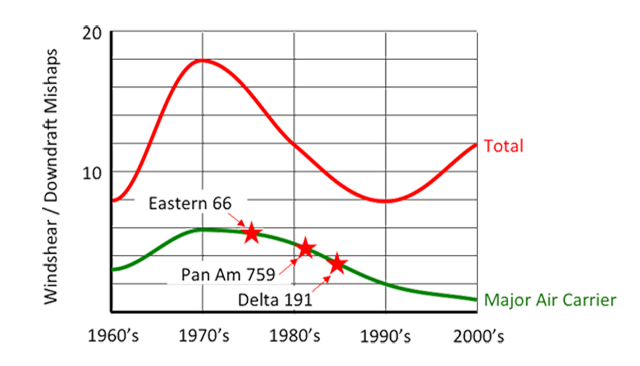
Total versus major air carrier windshear mishaps, by decade, 1960's to 2000's, data from Flight Safety Foundation
The aviation industry was shocked into action on June 24th, 1975, when Eastern Air Lines 66 continued an approach into shifting wind conditions despite a warning from a preceding aircraft. (Six crew and 106 passengers were killed. At the time, it was the deadliest single plane crash in U.S. history.) The flying public's awareness of windshear was certainly peaked on July 9th, 1982 with the crash of Pan Am 759 and then again on August 2nd, 1985 with the crash of Delta Airlines 191. While the 1980's were the worst decade for windshear-related deaths, the peak in numbers actually occurred in the 1970's. Grouping the mishaps by decades allows us to draw several conclusions:
- As awareness of the problem grew in the 1960's, aircraft manufacturers and major operators started to develop Windshear Escape Procedures, causing the initial drop in total mishaps.
- Following the heavy losses in the 1970's, Windshear Detection Technology was developed, leading to further drops at major airports with the ground-based equipment. Aircraft with airborne detection equipment also cut the mishap rate.
- In the 1980's the rate across most large aircraft types and major air carriers has fallen, partly attributable to better Windshear awareness / avoidance / escape training.
- The overall rate remains steady, indicating that subsets of the population don't have the necessary equipment or training. It is also worth noting that the Flight Safety Foundation statistics are for large aircraft only. The NTSB database, which includes smaller, general aviation aircraft contains nearly 400 incidents in the United States alone.
Note: I have not included mishaps prior to 1960. Of the 15 mishaps in the 1950's, the term "windshear" was only used 3 times. For the other occurrences, "severe downdraft," "divergent winds," or other phrases were used. The sharp rise from the sixties to the seventies correlates closely with the increase in commercial air traffic at the time.
References
(Source material)
Advisory Circular 00-54, Pilot Windshear Guide, 11/25/88, U.S. Department of Transportation
Aeronautical Information Manual
Air Force Manual (AFM) 51-9, Aircraft Performance, 7 September 1990
Airbus Flight Operations Briefing Notes, Adverse Weather
Airbus: Getting to Grips With Performance, Flight Operations Support & Line Assistance, January 2002
Aviation Safety Net
Boeing 737-700/800 Flight Crew Operation Manual, undated
Bombardier BD-700-700-1A10 Flight Crew Operating Manual, Rev 80, Jun 03/2014
Dassault Falcon 2000EX EASy Crew Operational Document for Dassault EASy 1 (CODDE), Revision 16, November 30, 2013
Flight Safety Foundation, Approach and Landing Accident Reduction Tool Kit - Windshear, August-November 2000
Gulfstream G450 Aircraft Operating Manual, Revision 35, April 30, 2013.
Gulfstream G450 Airplane Flight Manual, Revision 36, December 5, 2013
Gulfstream G550 Airplane Flight Manual, Revision 27, July 17, 2008
NTSB Aircraft Accident Report, AAR-83/02, Pan American World Airways, Inc., Clipper 759, Boeing 727-235, N4737, New Orleans International Airport, Kenner Louisiana, July 9, 1982
Please note: Gulfstream Aerospace Corporation has no affiliation or connection whatsoever with this website, and Gulfstream does not review, endorse, or approve any of the content included on the site. As a result, Gulfstream is not responsible or liable for your use of any materials or information obtained from this site.


